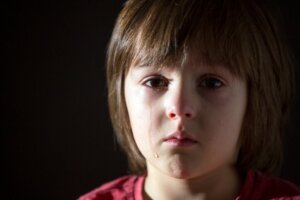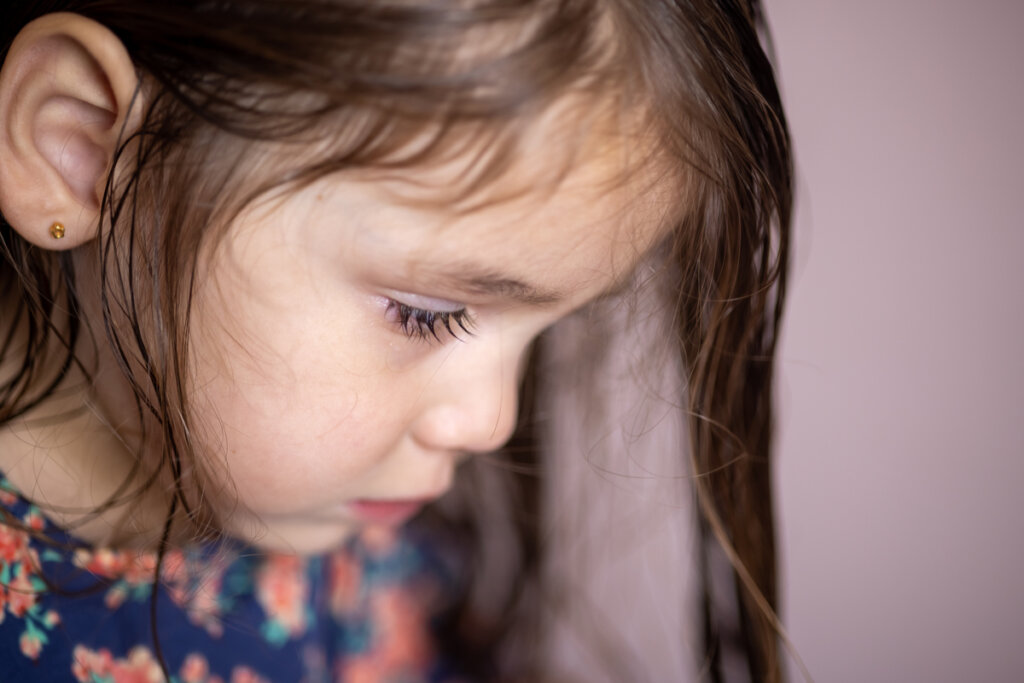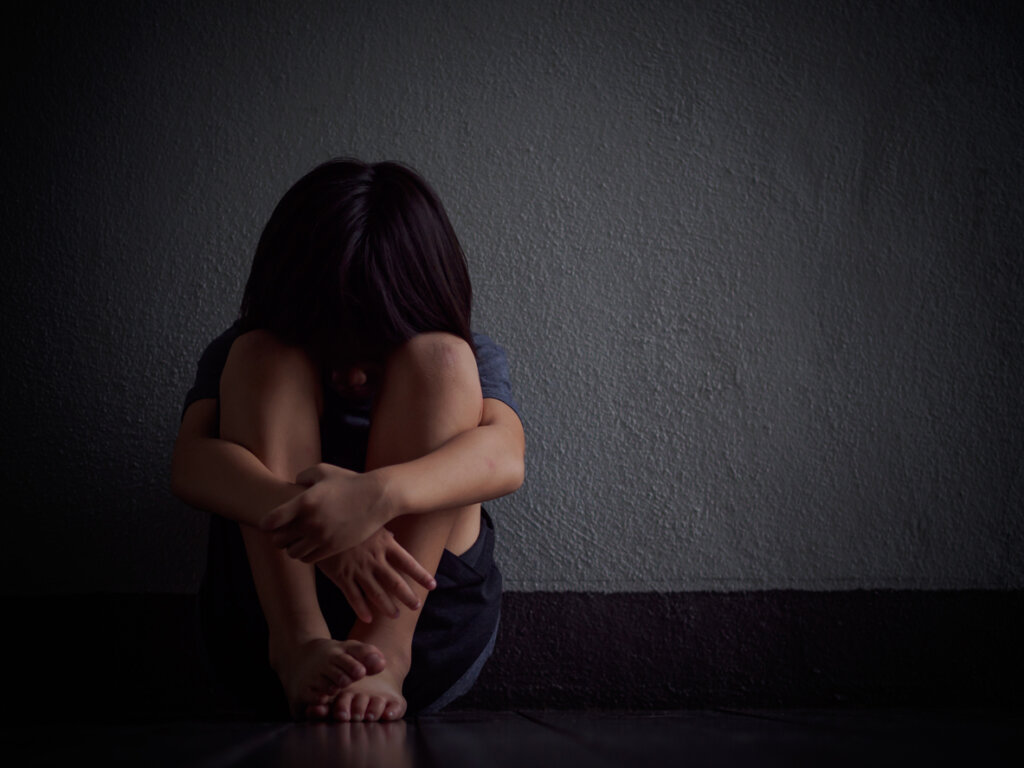What Happens to Abused Children?


Written and verified by the psychologist Gorka Jiménez Pajares
Children and adolescents are a population prone to post-traumatic stress disorder. This is more likely if they’ve been exposed to highly stressful or traumatic events. In fact, it’s estimated that three-quarters of the child population has experienced events likely to cause PTSD. For example, child abuse. Of these exposed children, one-third develop PTSD.
It’s known that child abuse can alter the neurodevelopmental process. It can also modify the way in which a child’s brain matures. This can produce cognitive deficits that persist into adult life. These children experience problems with attention, memory, language, or intellectual development.
Child abuse
Child abuse is defined as any act that violates the rights of the child. Among the different types of abuse, César Carvajal distinguishes between:
- Sexual abuse. Any type of sexual activity with a minor in which the aggressor is in a position of power and the minor is involved in acts that are beyond their understanding and will.
- Physical abuse. Any intentional action by an adult that results in physical harm, injury, or illness to a child.
- Emotional abuse. Carried out through insults, permanent criticism, ridicule, rejection, threats, or constant blocking of children’s initiatives.
- Abuse due to abandonment or negligence. Situations in which parents or primary caregivers neglect their duties to provide the care and protection that children need for their proper development.
“Childhood maltreatment has long-term consequences, in terms of increased psychopathology in adulthood: depression, anxiety disorders, severe personality disorders, substance abuse, eating disorders, somatization, and PTSD.”
-Carvajal-

Abused children
We’re going to explain the neuropsychology of abused children. In fact, abuse at an early age can cause irreversible psychological and neurological consequences. This occurs because childhood is the period during which the brain develops the most. However, it’s also true that its development continues during adolescence and even into adulthood.
“Broadly speaking, child abuse causes, among other effects, high mortality and morbidity, since it is estimated that more than ten percent of the cases of children suffering from mental retardation or cerebral palsy are due to abuse.”
-Mesa-Gresa-
In situations of abuse, the mechanisms of the stress response are activated. They produce adverse brain changes (Mesa-Gresa, 2011). Some of them are:
- Accelerated loss of neurons.
- Delays in myelination. Myelin is a substance that covers certain neurons. Among other factors, myelination favors the conduction of the nerve impulse.
- Abnormalities in the development of neuronal pruning. This is the natural creation and destruction process of neurons.
- Inhibition of neurogenesis. The inhibition of the birth of new neurons.
As a result of the above, alterations in brain functions occur. These occur mainly in the areas of the brain related to the regulation of executive functions.
“Therefore, mistreatment, abuse, and neglect during childhood can be considered as agents that interrupt normal brain development and which, depending on the age of onset and the duration of the abuse, can even produce considerable changes in some brain areas.
-Mesa-Gresa-
The hippocampus
The hippocampus is linked to long-term memory and declarative memory which is the memory of events that happen to us. Stress in early childhood can alter the structure of the hippocampus. In fact, the hypothesis is that high levels of stress in childhood could reduce its volume.
Furthermore, decreased hippocampal volume has been associated with symptoms of depression and dissociative thoughts. The reduction of the hippocampus also appears in borderline personality disorder. This condition is associated with early trauma. It’s negatively correlated with the onset and duration of childhood trauma.
“Functional manifestations of hippocampal changes in abused subjects are related to the amnestic, dissociative, anxious, and disinhibitory symptoms characteristic of PTSD.”
Mesa-Gresa-

The amygdala
The amygdala is in charge of processing and storing the emotional reactions essential for survival. It’s now known that early stress increases dopamine levels and attenuates serotonin levels in this structure.
Controversy exists as to whether the changes in the amygdala occur as a consequence of child abuse. However, studies have found, albeit weakly, a change in the total volume of the amygdala in children with PTSD, compared to non-abused children.
“In abused and neglected children, chronic activation of the amygdala may impair development of the prefrontal cortex, which could lead to age-dependent alterations in the acquisition of behaviors and emotions, including impulse control.”
-Mesa-Gresa-
Damage has also been detected in other structures, such as the cerebellar vermis. Alterations in this structure have been related to specific clinical entities. For instance, schizophrenia, autism, ADHD, or bipolar disorder.
As you can see, the effects of child abuse are multiple. Directly and indirectly, they affect the normative evolution of specific brain structures. Therefore, it’s a first-level problem that we must try and prevent at all costs.
Children and adolescents are a population prone to post-traumatic stress disorder. This is more likely if they’ve been exposed to highly stressful or traumatic events. In fact, it’s estimated that three-quarters of the child population has experienced events likely to cause PTSD. For example, child abuse. Of these exposed children, one-third develop PTSD.
It’s known that child abuse can alter the neurodevelopmental process. It can also modify the way in which a child’s brain matures. This can produce cognitive deficits that persist into adult life. These children experience problems with attention, memory, language, or intellectual development.
Child abuse
Child abuse is defined as any act that violates the rights of the child. Among the different types of abuse, César Carvajal distinguishes between:
- Sexual abuse. Any type of sexual activity with a minor in which the aggressor is in a position of power and the minor is involved in acts that are beyond their understanding and will.
- Physical abuse. Any intentional action by an adult that results in physical harm, injury, or illness to a child.
- Emotional abuse. Carried out through insults, permanent criticism, ridicule, rejection, threats, or constant blocking of children’s initiatives.
- Abuse due to abandonment or negligence. Situations in which parents or primary caregivers neglect their duties to provide the care and protection that children need for their proper development.
“Childhood maltreatment has long-term consequences, in terms of increased psychopathology in adulthood: depression, anxiety disorders, severe personality disorders, substance abuse, eating disorders, somatization, and PTSD.”
-Carvajal-

Abused children
We’re going to explain the neuropsychology of abused children. In fact, abuse at an early age can cause irreversible psychological and neurological consequences. This occurs because childhood is the period during which the brain develops the most. However, it’s also true that its development continues during adolescence and even into adulthood.
“Broadly speaking, child abuse causes, among other effects, high mortality and morbidity, since it is estimated that more than ten percent of the cases of children suffering from mental retardation or cerebral palsy are due to abuse.”
-Mesa-Gresa-
In situations of abuse, the mechanisms of the stress response are activated. They produce adverse brain changes (Mesa-Gresa, 2011). Some of them are:
- Accelerated loss of neurons.
- Delays in myelination. Myelin is a substance that covers certain neurons. Among other factors, myelination favors the conduction of the nerve impulse.
- Abnormalities in the development of neuronal pruning. This is the natural creation and destruction process of neurons.
- Inhibition of neurogenesis. The inhibition of the birth of new neurons.
As a result of the above, alterations in brain functions occur. These occur mainly in the areas of the brain related to the regulation of executive functions.
“Therefore, mistreatment, abuse, and neglect during childhood can be considered as agents that interrupt normal brain development and which, depending on the age of onset and the duration of the abuse, can even produce considerable changes in some brain areas.
-Mesa-Gresa-
The hippocampus
The hippocampus is linked to long-term memory and declarative memory which is the memory of events that happen to us. Stress in early childhood can alter the structure of the hippocampus. In fact, the hypothesis is that high levels of stress in childhood could reduce its volume.
Furthermore, decreased hippocampal volume has been associated with symptoms of depression and dissociative thoughts. The reduction of the hippocampus also appears in borderline personality disorder. This condition is associated with early trauma. It’s negatively correlated with the onset and duration of childhood trauma.
“Functional manifestations of hippocampal changes in abused subjects are related to the amnestic, dissociative, anxious, and disinhibitory symptoms characteristic of PTSD.”
Mesa-Gresa-

The amygdala
The amygdala is in charge of processing and storing the emotional reactions essential for survival. It’s now known that early stress increases dopamine levels and attenuates serotonin levels in this structure.
Controversy exists as to whether the changes in the amygdala occur as a consequence of child abuse. However, studies have found, albeit weakly, a change in the total volume of the amygdala in children with PTSD, compared to non-abused children.
“In abused and neglected children, chronic activation of the amygdala may impair development of the prefrontal cortex, which could lead to age-dependent alterations in the acquisition of behaviors and emotions, including impulse control.”
-Mesa-Gresa-
Damage has also been detected in other structures, such as the cerebellar vermis. Alterations in this structure have been related to specific clinical entities. For instance, schizophrenia, autism, ADHD, or bipolar disorder.
As you can see, the effects of child abuse are multiple. Directly and indirectly, they affect the normative evolution of specific brain structures. Therefore, it’s a first-level problem that we must try and prevent at all costs.
All cited sources were thoroughly reviewed by our team to ensure their quality, reliability, currency, and validity. The bibliography of this article was considered reliable and of academic or scientific accuracy.
-
Marty, C., & Carvajal, C. (2005). Maltrato infantil como factor de riesgo de trastorno por estrés postraumático en la adultez. Revista chilena de neuro-psiquiatría, 43(3), 180-187.
-
Mesa-Gresa, P., & Moya-Albiol, L. (2011). Neurobiología del maltrato infantil: el ‘ciclo de la violencia’. Revista de neurología, 52(8), 489-503.
This text is provided for informational purposes only and does not replace consultation with a professional. If in doubt, consult your specialist.







